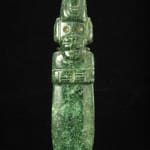Guanacaste-Nicoya Jade Figure-Celt Pendant with a Large Headdress, 100 CE - 500 CE
Jade
height 16.5 cm
height 6 1/2 in
height 6 1/2 in
PF.4298
In the context of Pre-Columbian art and archaeology, jade is a generic term that refers to any variety of hard, dense stones that were worked with great skill by native...
In the context of Pre-Columbian art and archaeology, jade is a generic term that refers to any variety of hard, dense stones that were worked with great skill by native artists. Although jade is generally thought to be green, it can actually be a range of colors. Jade carving flourished in ancient Costa Rica for over a thousand years, roughly from 500 B.C. to 900 A.D., although the period of greatest artistic accomplishment lasted from 300 to 700 A.D. It is believed that jade working began during an extended period of agricultural abundance that allowed the ancient society to dedicate part of its energies toward the cultivation of artistic pursuits.
Jade was considered to be a sacred material by the ancient populations of Costa Rica, held in even higher esteem than gold. Generally, it was thought to symbolize that vital life force that sustains us all. The color green is naturally associated with verdant plant life. Specifically, jade was thought to symbolize the sprouting maize plant, that staple of the Pre-Columbian diet. It has also been suggested that jade represents water. Either way, we can be certain that jade represented the very essence of life itself.
To date, no native sources of jade have been discovered in Costa Rica, suggesting an extended trade network existed that imported this precious resource from Mesoamerica into Costa Rica where it was carved by local artists. Such trade also would have brought great wealth and likely reinforced the social stratification of the peoples. Jade may have served as a status marker to distinguish the elite from the masses and solidify their hold on power. We can picture an ancient ruler or shaman presiding over a sacred ceremonial adorned in brilliant green jade pendants and jewelry. The ancient Costa Ricans believe that the system of social hierarchy also extended into the afterlife. Therefore, jade objects were buried with the elite so that their power could be maintained throughout eternity.
Jade figure-celts are one of the most typical forms of Pre-Columbian lapidary work from Costa Rica. Their exact meaning is a mystery, and their symbolism most likely derives from the equally mysterious Olmecs. This beautiful celt is in the classic style, with an anthropomorphic or avian figure carved on top of a blade. The high crest on the head suggests the brilliant plumage of the quetzal, a beautiful bird greatly admired in Mesoamerica, particularly by the Maya. The fact of the hands folded neatly over the abdomen is like the ritual pose of a shaman-priest, who may have worn a headdress made from the quetzal feathers. Unlike the Olmec Celts, those of Costa Rica have perforation holes, which show they were meant to be worn. There is little doubt the figure-celt pendant was a symbol of authority, worn by important individuals during ritual ceremonies. This gorgeous jade and fine carving combine to heighten the magic and mystique of this elegant pendant.
Jade was considered to be a sacred material by the ancient populations of Costa Rica, held in even higher esteem than gold. Generally, it was thought to symbolize that vital life force that sustains us all. The color green is naturally associated with verdant plant life. Specifically, jade was thought to symbolize the sprouting maize plant, that staple of the Pre-Columbian diet. It has also been suggested that jade represents water. Either way, we can be certain that jade represented the very essence of life itself.
To date, no native sources of jade have been discovered in Costa Rica, suggesting an extended trade network existed that imported this precious resource from Mesoamerica into Costa Rica where it was carved by local artists. Such trade also would have brought great wealth and likely reinforced the social stratification of the peoples. Jade may have served as a status marker to distinguish the elite from the masses and solidify their hold on power. We can picture an ancient ruler or shaman presiding over a sacred ceremonial adorned in brilliant green jade pendants and jewelry. The ancient Costa Ricans believe that the system of social hierarchy also extended into the afterlife. Therefore, jade objects were buried with the elite so that their power could be maintained throughout eternity.
Jade figure-celts are one of the most typical forms of Pre-Columbian lapidary work from Costa Rica. Their exact meaning is a mystery, and their symbolism most likely derives from the equally mysterious Olmecs. This beautiful celt is in the classic style, with an anthropomorphic or avian figure carved on top of a blade. The high crest on the head suggests the brilliant plumage of the quetzal, a beautiful bird greatly admired in Mesoamerica, particularly by the Maya. The fact of the hands folded neatly over the abdomen is like the ritual pose of a shaman-priest, who may have worn a headdress made from the quetzal feathers. Unlike the Olmec Celts, those of Costa Rica have perforation holes, which show they were meant to be worn. There is little doubt the figure-celt pendant was a symbol of authority, worn by important individuals during ritual ceremonies. This gorgeous jade and fine carving combine to heighten the magic and mystique of this elegant pendant.



